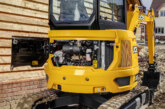Ben Bennett is the managing director at virtual reality specialists Luminous Group. Here, he shares his top tips for training employees in high-risk industries.
It’s no secret that working in any industry can present many potential dangers. Recent statistics show that there were 2,620 incidents of workplace injuries in the construction industry over the last 12 months, while similar results were also seen for other high-risk industries, with 2,180 incidents happening in the manufacturing sector over the same period (HSE).
As a director or site manager, there are steps you can take to safeguard your workforce, and perhaps the most important of these is training. And, with new virtual reality (VR) technology becoming more accessible, it’s easier than ever to provide in-depth training without exposing staff to danger or risking expensive equipment. Here, I’ll be sharing how VR can make all the difference to high-risk industries.
It can be used to create virtual hazards
The whole point behind the latest technology is to present your workers with the opportunity to experience — and be prepared for — dangerous situations which could cause injury or fatalities, without having to cause either of these things. By simulating situations that would be too dangerous to put your workers in in real life, they will get the necessary knowledge and experience, without being exposed to high-levels of risk and harm.
For example, working in construction can include using power access platforms, working at heights and operating heavy machinery. But, if you don’t currently have a construction site to train staff on, using VR technology can help to save you time and effort, and will effectively prepare your workers for potential danger.
Some VR specialists will have their own ready-made experiences covering generic hazards for a range of industries which will enable you to create plans for your workforce. However, there are also many others that will create custom VR solutions if you need to train your workforce on something specific to your business.
It can prevent accidental damage
Although traditional training can be effective, in some instances recreating hazardous situations can cause damage to both your equipment and workplace, which takes time and money to repair or replace. With VR, the need to risk your expensive tools and machinery is removed while still giving your staff a realistic experience and scenario to solve. This can make VR training more affordable in the long-run compared to other methods, particularly as once you’ve covered the initial expense of the software it’s much cheaper to run.
It engages your workers through gamification
We all know that despite being important, training can be difficult to engage with — especially when the sessions are long and spent watching outdated training videos. But, with VR there is an immersive and interactive element, which mimics gaming and makes it a more fun experience for everybody being trained.
There are even options to win points for spotting and dealing with hazards correctly, which will add to the gamification and encourage a competitive atmosphere. Plus, as VR is completely immersive, your staff may be more likely to remember how to deal with a certain problem than they would be with traditional training methods, thereby lowering the risk of injuries and fatalities and increasing productivity and morale.
It can use less time and money
In any industry, keeping your staff productive and doing as much quality work as they can in their working hours is key. And, although you should never scrimp on the time spent training, if the results are just as or more effective than traditional methods, then this is an added bonus.
VR removes the need to create smaller scenarios and train your staff on it, as well as recreating a larger scene which can be timely and costly to build. Plus, the fact each person gets to experience tackling the problem in exactly the same way means that everyone will get the same level of quality training, which could be time-consuming if you had to run through this with each person individually. This technology can also be cheaper from an insurance perspective as there’s much less risk than with traditional hands-on training. So, VR can result in effective training in less time and at a more affordable cost.
When you manage staff who work in high-risk industries, it’s key that they get the best training possible to deal with hazards. And, with the latest VR technology providing just that, as well as encouraging collaboration and using less resources, I recommend giving it a go today.









